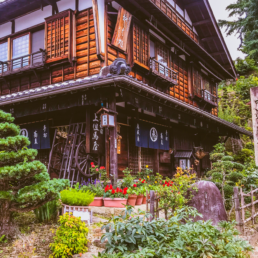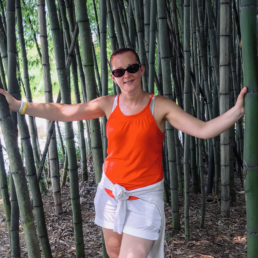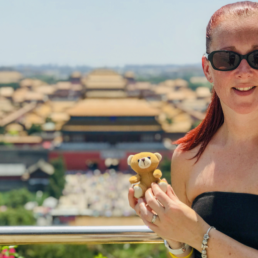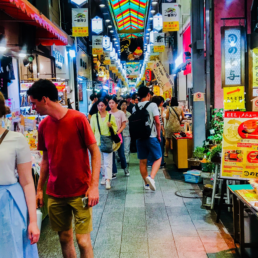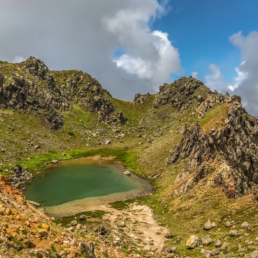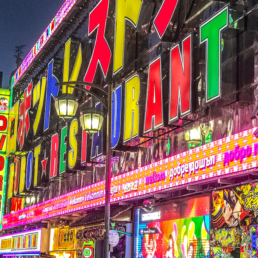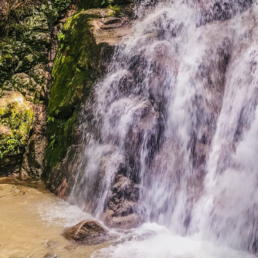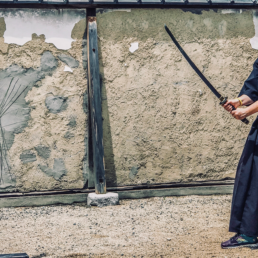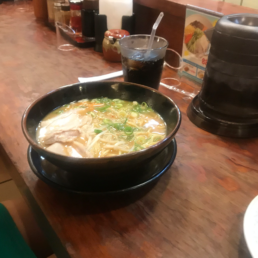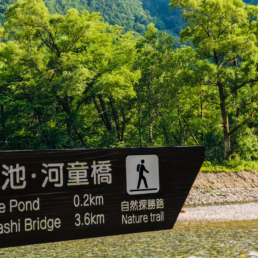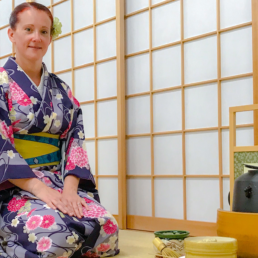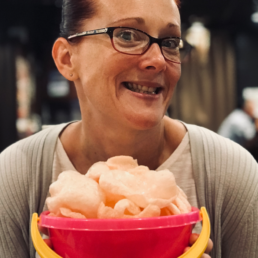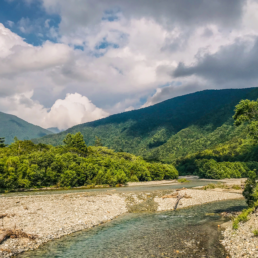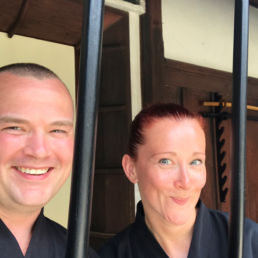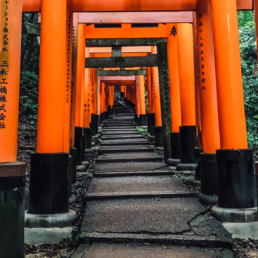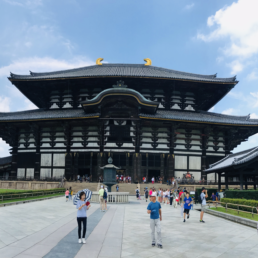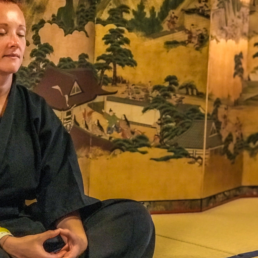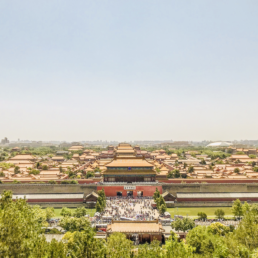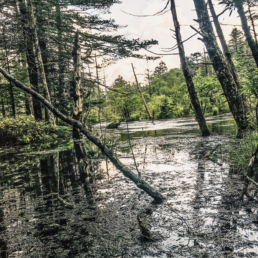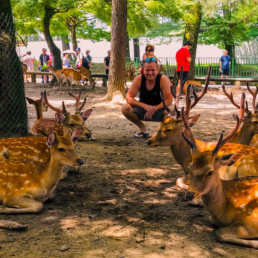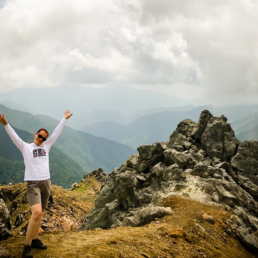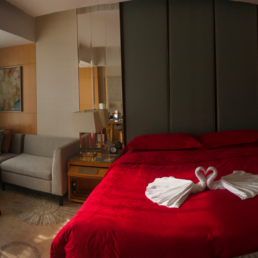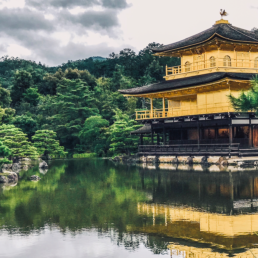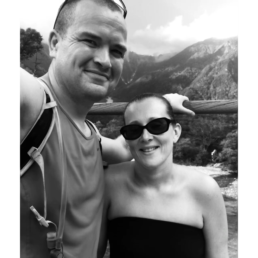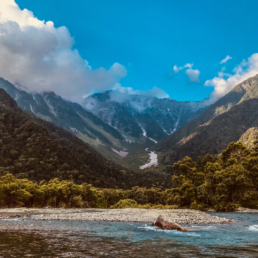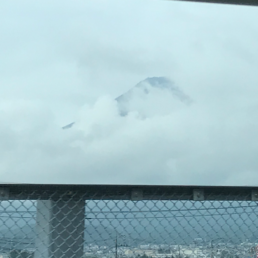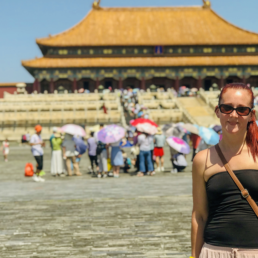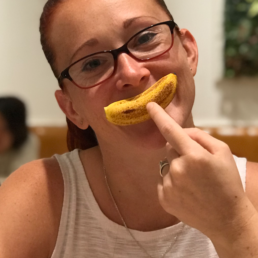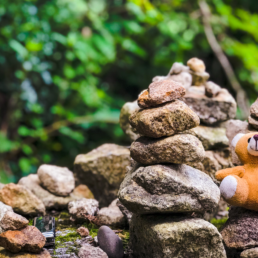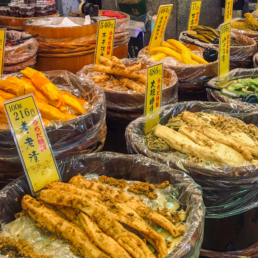After our fertility diagnosis Steve and I decided we wanted some time to re-connect as Tasha and Steve, husband and wife before starting IVF. We’d spent the last 2 years living appointment to appointment and it had been stressful and had caused a lot of arguments, so when Steve asked me if I could go anywhere in the world, and I couldn’t do it with kids, where would I go? ….
…Voila, Japan and China!
Before we start I’m sorry it’s so long. We just did so many amazing things, I don’t want you to miss out if I leave something.
Travel
Flight from Manchester to Haneda (Tokyo) with a quick stop in Paris on the way there. FlyBe for our short flight and Air France the rest of the way. Would definitely recommend Air France – good service and entertainment and the meals aren’t bad either. I managed to keep myself entertained for the 12 hour flight between the film selection and napping.
Customs was very easy – British citizens travelling to Japan as a tourist for less than 90 days do not need a visa. Once in the airport I suggest getting a transport card of some sort if you plan on travelling between cities. In Japan there are two main ways to travel; Japanese ‘Railpass (JR Pass) or ‘Pasmo’ card. The benefit of a JR pass is unlimited travel on JR trains and JR buses within 7, 14 or 21 days (trains are very smart and clean and normally a lot quicker than buses, although not always). The downside is the subway and some buses and trains are not included so you do need to check first. Pasmo on the other hand is better for an odd number of days eg 10 day trip and can easily be topped up in shops, petrol stations, cafes etc. Pasmo can also be used on buses and subways. If you aren’t sure which will be best for you, have a look on the JR pass website as it has a calculator that calculates whether a JR pass would be beneficial or not. Ours worked out that Pasmo would be better so purchased that at the kiosk (with a 500 yen refundable deposit if the card is returned before you leave the country) and we put 6,900 Yen credit onto each card.
Finding your way around using signs isn’t difficult as most signs are in English as well as Japanese ‘Hirangana’ (one of the Japanese alphabets). On a side note, knowing where you are going and how to get to places is even more important when you are not comfortable with the language so you have three choices; one, use your data and have to pay whatever your own provider charges outside the EU; two, rent a pocket wifi box at the airport (small boxes you carry with you to give you signal – normally between £3 and £10 per day) or do like we did and use the hotel wifi each morning and screenshot the directions. We never had any problems that we couldn’t sort out easily.
All of the places we visited on our trip were recommended by other bloggers or on the ‘must see’ list on Tripadvisor etc – I really don’t think you can go too wrong this way, and you can tailor your experiences to things you like to see/do. I find everything about the shrines, meditation and Buddhism fascinating so completely wanted to immerse ourselves in that side of Japanese culture and history from the moment we arrived.
Tokyo
Hotel
We stayed in the ‘Hotel Sunroute Plaza Shinjuku’ because most of the things we wanted to see were close by. The only downside, and this was all hotels (and they weren’t cheap – this one being £351 for 3 nights), the rooms were all very small, always having one side of the double bed (never any queen or king rooms) against one wall and literally just enough room to manoeuvre and that’s it. So be aware.
Places to visit/things to do
Meiji Shrine in Yoyogi Park was about a 20-25min walk from our hotel. Now there are quite a few rituals which will help you when in Japan e.g. cleaning your hands before entry to the shrine. At the ‘purification fountain’, take one of the ladles provided in your right hand, fill it with fresh water and rinse your left hand. Then swap hands and do the same with the right hand. Finally transfer some water into your cupped hand, rinse your mouth and spit the water beside the fountain. You are not supposed to transfer the water directly from the ladle into your mouth or swallow the water. Do not return any water from the ladle into the fountain, just get rid of it. Another ritual, when saying a prayer, first throw a coin into the offering box, bow deeply twice, clap your hands twice, bow deeply once more and pray. If there is some type of bell or gong, use it before praying in order to get the spirit’s attention.
You also cannot miss Senso-ji temple. Here we paid 100 yen each for a ‘fortune’ stick known as ‘omikuji’. Basically they are randomly drawn predictions with good/bad fortunes. First of all you pay, shake the silver canister which has sticks in it, take one out (it will have a number on it) and find the corresponding drawer for that number. You then take your fortune slip that ‘decides your fate’ – English translations available! Luckily, I drew good luck (wohoo) so I took my fortune with me, as recommended. Steve on the other hand drew bad luck so he had to tie his on the rack and leave his fortune behind for the temple priests to pray for the bad luck to go away!
A quirky thing to do in the area is Shibuya Crossing – meant to be the busiest crossing in the world with hundreds of people, up to thousands at peak time, crossing the road at once coming from all different directions. The busiest time to go is a Friday or Saturday night after dark (well as dark as it can be with all those neon lights everywhere).
The weirdest (but coolest) thing we did was definitely the Robot restaurant. I don’t think my description of it will do it justice so I urge you to look at a Youtube clip of it. It is, quite simply, a show with actors dressed up and extravagant floats dramatising a story to music. However, there are neon lights, huge robots and craziness too. watch video clip
Mt. Fuji is only a two hour bus ride away (1,750 yen each) so if it is good weather I’d strongly urge you to go. Unfortunately a lot of the time Fuji is covered by cloud, like it was when we visited, so it wasn’t as we had hoped. There are other things to do like walk round Lake Kawaguchiko which is nice, maybe better on a sunny day – we had cloud and rain.
If you are looking for old traditional Japan then look no further than Omoide Yokocho, meaning Memory Lane which is a small area of narrow alleyways of restaurants and food halls. Most of the buildings are dilapidated and house maybe 6-8 people max, but are a reminder of how streets used to look. Food here is expensive but it is certainly a cultural experience and well worth the extra.
Food
Breakfast on our first morning was at ‘Cafe Veloce Minanishinjuku’ on the same street as our hotel (pretty much opposite). Ok little cafe but very strange things on the menu for breakfast. Steve had the breakfast meal deal which included a brioche bun with sausage (hot dog really), plus a small side salad (bit odd for breakfast) and a coffee (490yen) whilst I had a ham + lettuce sandwich (260yen). On our final morning it was at ‘’Fruit Parlour Kajitsuen’’ which again was on the same street as our hotel. It had some self service and some waiter service but the food was pretty good. Most items on the menu included fruit which was great for us; although I’m still not convinced on the sandwiches they had stuffed with fruit and cream cheese!
For lunch we mainly snacked but one time we had food directly opposite our hotel in a food hall called ‘Blast’. Steve and I ordered some BBQ meat and it was yummy, but you could have had traditional sushi, pizza, Mexican or Italian there.
Probably my favourite meal in Tokyo though was at ‘’Ismoaru Suisan’’ on the corner of our street by our hotel. Unfortunately their air con had broken to it was sweaty as hell but the food was simply amazing. Of course, everything was in Japanese so it was a case of look at the pictures and point (so embarrassing for a linguist – as she holds her head in shame). Most of the food was cooked in front of you and for other bits you were given a heater to cook yourself.
Matsumoto
Travel
From Tokyo to Matsumoto you can take the bus – just over 3hrs and 3800 yen one way or the train – just over 2.5hrs and 6600 yen one way. We took the bus as for an extra half hour we felt it wasn’t worth almost double the amount.
Hotel
We stayed at the Hotel Lidaya (£143 for 2 nights) opposite the train station. A bit more basic than the Sunroute in Tokyo but still comfy and we knew we were having very busy days out so extravagance didn’t matter. Also you can do laundry for a small fee (annoyingly it said for free on booking.com but only cost 800 yen (about £5)) so wasn’t too bad.
Places to visit/things to do
Must see places include Matsumoto Castle and the surrounding grounds. We arrived just before 4pm and it closes at 4.30pm so we didn’t have long, but to be honest 45mins-1hr is all you need. Important to note that in one section of the castle it has incredibly high step ladders (similar to those in the Anne Frank museum if you have been there) so please bear this in mind if you travelling with someone who might struggle. If you plan on a visit to Matsumoto this is certainly the top thing to see.
A quirky place to visit is Nawate Street with its row of small shops and reoccurring frog theme. This is because the banks of the river used to echo with the sound of frogs abut 100 years ago. ‘Kaeru’ is the word for frog in Japanese but it also means ’to return home’, thus, as a symbol of frog history and to invoke a safe return home, a statue of a frog marks the entrance to the street.
As Matsumoto is noted as ‘the entrance to the Japanese Alps’ there is a picturesque mountain backdrop whenever you go in town, so it is lovely to simply wander and take in the sights and scenery.
Food
Food on the first night was at ‘Torimero Matsumoto Station’ – definitely recommended, where again we used the pictures to help us decide our food choices. It also has shrimp crackers to die for (I am a woman of very specific tastes and one of them is prawn crackers!!)…I had 2 buckets full!
As we would be heading to Kamikochi the next morning we stopped off at Lawson (mini market) for breakfast food – croissants, yoghurt and fruit, so that we could eat it on the bus. No issues at all finding snack type foods in the numerous mini marts around tourist areas.
Kamikochi – Japanese Alps
In our opinion (I know I speak for Steve as well as myself here) no trip to Japan can be complete without visiting this absolutely stunning area. Japan of course is known for its technology and big concrete cities but this is the complete opposite; stunning nature and absolute peace and tranquility.
Travel
As we took the first bus in the morning to Kamichoki (5.30am) it was direct – the only other direct bus after this is 10.15am; all the other times it is a train from Matsumoto to Shin Shimashima Station and then a bus to Kamikochi. The one way fare is 2450 yen, while a discounted round trip ticket costs 4550 Yen. It is important to note that private cars cannot enter Kamikochi so you’ll have to get the bus there. Also the JR Pass is not valid on these trains and buses.
Places to visit/things to do
Some tourists like to hike some of the mountains however they can be a bit of a challenge; we climbed Mt. Yakadake (actually an active volcano – and yes it does smell of rotten eggs in places) which was apparently one of the best but still takes about 7-8 hours and your fitness needs to be fairly good. There are sections which are ‘interesting’ shall we say – a ladder propped up against the side of a section of mountain, with some rope as a makeshift climbing apparatus, and the final ascent is quite steep. We ended up tagging along with a German guy we met at the bus station in Matsumoto; lovely guy….very bad sense of direction so we ended up walking for probably an extra 2 hours than needed. I think I should take this opportunity to point out that the day we visited Kamikochi and Steve hauled my ass up said volcano, was in fact our fourth wedding anniversary – I’d like to think most other men are sensible enough to book a spa weekend or something equally as relaxing for their wives and not be this idiotic!!
Most people however like to hike the trails along Azusa River from Taisho Pond to Myojin Bridge because it is mostly flat and you don’t need to have any experience. We did this in the afternoon as a cool down after the epic hike. The views and surroundings were incredible so we chose this as a spot to scatter some of Pea’s ashes – so now he is over Old Man Coniston in the UK, the Grand Canyon in the USA and Kamikochi in Japan – I wonder where he’ll be next?!)
Magome + Tsumago
This again was a day trip from Matsumoto but instead of returning to Matsumoto we headed on to Kyoto. After some research of the Nagano area, I noticed that a lot of people wanting to see ‘old’ Japan walked the trail from Magome to Tsumago. A fairly easy trail, more of a road through the forest and into some mountain villages than an actual hike. Online it says 2-3 hours for the 8km but if you walk like Steve and I then it’s more likely to be 1.5hrs.
Travel
We bought the train tickets that morning from Matsumoto to Magome via Takayama (you need to change trains here but it is very simple – everyone in the station sees tourists and wants to help!) The cost from Matsumoto to Takayama is 3,200 yen each and then from Takayama to Magome is 3,250 yen. There are plenty of signs along the walking trail so you can’t get lost – even I managed it and I can’t read a map for toffee!
You’re probably thinking “Tell me they didn’t take their suitcases with them if they had already left the hotel!” No! Storage lockers are a thing in a lot of Japanese train/bus stations and don’t cost a lot at all, so when we arrived in Magome we paid for two lockers, one large (500 yen) and one small (300 yen) for the day. At the end of the trail we simply caught the bus back to Magome, collected the suitcases and then headed to Kyoto.
The first train was to Nagoya and cost 1,134 yen each. The second was the Japanese Shinkansen – the bullet train which reaches up to 200km an hour, and this was much more expensive but totally worth it at 5,170 yen each. You can’t go all the way to Japan and not experience this. It is a must!
Kyoto
Kyoto is said to be the cultural capital of Japan’s main island and this is certainly true. No trip to Japan would be complete without visiting Kyoto.
Hotel
Now with the hotels I made a mistake and originally only booked Kyoto for 2 nights and when I tried to book the hotel for a third it was full so I had to book another – note to self, always check! Our hotels were the Sunroute Kiyamachi (£95 for 2 nights) and the WBF Gojo Omiya (1 night). Both were close to the things we wanted to see and do and very reasonably priced in comparison with Tokyo.
Places to visit/things to do
As previously mentioned, there are lots of superb things to see and do in Kyoto. The ones we were interested in were Nijo Castle, Nikishi Market, the Gion district, Pontocho Alley, Kinkaku-ji and Fushimi Inari. Nijo Castle (600 yen each) and Kinkaku-ji (400 yen each) are buildings to walk around and would take possibly an hour each. Nikisha market is amazing. We’ve probably all seen big markets with fresh produce being sold, but the variety and weirdness of produce on sale; anything from mini octopi to gigantic crab legs. The Gion district and Pontocho Alley are traditional areas similar to Memory Lane in Tokyo with the slight difference that these areas are where the geisha are (women who are highly trained entertainers in the arts of singing, dancing and playing musical instruments). Alas they are extremely difficult to find as you are walking around unless you pay, a lot, to have a tour done by one – one of the ladies I spoke to prior to our trip said she had lived there for 4 years and never saw one, then when she went back on holiday for a week she saw one! Fushimi Inari is a very famous shrine dedicated to the goddess Inari who is the goddess of….you guessed it, fertility. Obviously this is something I wasn’t going to miss, especially as it is filmed in one of my favourite Japanese movies; Memoires of a Geisha. The walk itself is quite tiring, even though mostly flat there are A LOT of steps, like 12,000 of them! So DEFINITELY bring water, and maybe a defibulator!!
The experiences we did were out of this world. I treated us (£90 each!) to a Samurai experience first and Steve spoke of pretty much nothing else for the rest of the day and probably the rest of the trip. Worryingly he is actually very very good with a samurai sword – like so good the instructor says he’s never, in the 12 years he’s been doing this, has he seen someone as good! So if you’re ever in danger you want me with a gun (we went to a gun range on our honeymoon and I nailed it!) and Steve with a samurai sword! You get to see it being used properly and you have a go yourself.
The Kimono Tea Ceremony was definitely more for me but Steve enjoyed it too (£36 each). First we both got dressed up in kimonos and I got my hair done, then we were led through the tea ceremony, the history of it and how to make it, and we finally got to do it ourselves. The whole process was fascinating and it’s incredible to see how just making a put of tea can be so ritualistic.
Food
Once or twice we stopped at mini marts to grab some yoghurts and pastries for breakfast and sushi for lunch. This was just quick and easy. I would however say the best night we had in Kyoto was on Kawaramachi-dori St. Again we definitely stubbled across a locals restaurant as the entire time we were there we were treated like royalty, although sure they were laughing at us as every so often we did something and there would be a roar of laughter from both bar staff and customers. they were good though as I wanted a Coke and rather than say (like in the UK we would have done) ‘Sorry, we’re out’ the guy went outside in the torrential rain and went to the nearest mini mart and came back with a big bottle of it! Haha An awesome night.
Osaka/Nara
I have to admit that even though Osaka is the second largest city in Japan I was disappointed with what it had to offer. I suppose because we had already seen so many shrines and temples we weren’t really bothered with seeing any more. Plus we were getting very tired after 10 days of epic walking and sightseeing so we rested in the hotel for a while the day we arrived.
Hotel
Our hotels were the Doutonbori Crystal Hotel IV (£31) and the Aston Plaza Kansai Airport (£66). We got one close to the hotel as our flight to Beijing was fairly early in the morning. Also this hotel had a free airport shuttle which made things a lot easier. It even included a small breakfast.
Places to visit/things to do
On our first day we went to Shinsaibashi-suji (market streets) and wandered the tiny alley ways, similar to Nikisha in Kyoto. That evening we went to Dotonbori which is said to be the entertainment district and it certainly was with all the neon lights and gaudy signage. Very Robot Restaurant style, but so different from what we are used to, I loved every minute.
Our next day was much more us, with a trip to Nara and the deer park. When you exit the train station you are great with hundreds, and yes I mean hundreds, of deer. Due to the fact that they have learnt, that if they are friendly then people will feed them, they are all along with footpaths and side streets leading to Todai-ji temple and Kasuga taisha shrine (500 yen each to enter).
Food
After spending the day at Nara and bearing in mind we needed to be up early the next day we decided to eat at the train station back in Osaka. Nanba walk Nijinomachi is a lovely local place where we finally had ramen – yummy! Oh and quick note, slurping in Japan is actually a sign you are enjoying your meal so slurp away!
Final thoughts
Japan is INCREDIBLE! Steve went because it was my dream but even he said he had an amazing time and would be happy to return. People are friendly, the cities are bonkers, the views in the countryside/mountains are out of this world and the culture, well, just so different! GO TO JAPAN!
China
So, I have always wanted to walk the Great Wall of China, I mean, who wouldn’t?! Unfortunately, as I was rushing to plan this trip I hadn’t taken into account the cost of the visa we would need for only 3 days there. £151 each! For 3 days!! Not only was I furious with myself for that but getting the visa in the first place was an absolute nightmare. We needed to go to Manchester and get it but they are only open from 8am to 5.30pm Monday to Friday so it certainly isn’t helpful for people who work. Then when we got there the people who worked there were a stickler for any minute detail wrong/missing from the form – we ended up having to amend it. Then, as it was technically a brand new form (literally added my middle name on the front page) it had to be printed off again…which we had to do and pay for. They had a printer so I didn’t think it would be too bad, but their printer wasn’t working. They directed us to the library which had printers so again thought it would be ok. Nope! Their printer system down. Long story short with the printing it took us 2 hours to do this – had to visit a nearby internet cafe TWICE. Then if that wasn’t bad enough, they still said they couldn’t give us our visas as we hadn’t booked our flight from Osaka to Beijing. They didn’t seem to have a problem with us leaving the country, just entering it! PLEASE PLEASE PLEASE make sure you have every tiny detail planned and do not expect it to run smoothly, that way you can’t get annoyed when all hell breaks loose.
Beijing
Travel
Our flight from Osaka to Beijing was with Asiana Airlines. I am a very nervous flyer after a bad experience in my uni days so did a lot of research with aircraft safety and crashes of this and other Chinese airlines. Obviously I am used to European and American airlines but having never travelled this way before I wanted to make sure I was safe. To their credit they weren’t bad at all and the connecting flight in Seoul was very easy.
The simplest way to get to downtown is via the Airport Express Line. There are stations at Terminal 2 + 3. The journey to the city takes 16 to 20 minutes, and a one way ticket costs 25 RMB.
Now as a language teacher and lover of pretty much everything foreign I have to say I am not the greatest fan of some Chinese people in major cities on the underground. The etiquette here is even different to that in London, and I don’t particularly like that either. Not only do people think it is appropriate to invade your personal space and breathe (and cough! Yes for some reason some people in China think it is acceptable to cough and not put your hand over your mouth!) all over you, but they also think it is ok to sit on your pretty much brand new luggage and use it as a seat. Grrr – sorry rant over.
Hotel
Our hotel, well, it was just incredible! The Pan Pacific Beijing (£327) was close to all the places we wanted to visit in the city and was nothing like Japanese hotel rooms. It was HUGE!. We had a massive bed in the middle of the room, sliding doors leading to our amazing bath, separate shower and sliding doors to our toilet (with phone inside – I’ve never understood that). A fruit hamper was there waiting for us with a note from management ‘Enjoy your stay’. We also had floor to ceiling windows so got a pretty good view too.
Places to visit/things to do
As we only had 3 days to explore Beijing I knew I had to plan smart, especially as one of those days would be a trip to the Great Wall. The things I wasn’t prepared to miss in Beijing were Tiannemen Square, the Forbidden City, Jingshan Park and some Hutong areas. Tiannemen Square (free to enter) is of course very famous for its massacre in June 1989 and the Forbidden City (40 CNY low season, 60 CNY high) is the old imperial palace during the Ming dynasty. Jingshan Park (2 CNY) is on a hill overlooking the Forbidden City so therefore a great place to get incredible pictures of the palace and surrounding areas although bear in mind it is quite a trek up some steps and can be quite tiring. A lot of Hutong areas around Beijing have been destroyed but there still remain a small handful. Hutongs are lanes or alleys (ranging from 40cm to 10m wide) made by traditional courtyard households on both sides. They represent what life was like in ‘old’ China.
On our first day in Beijing we had planned to do the Forbidden City but we wasted a good 2 hours because after all the checks and stops to get into the City they refused us entry, one because we didn’t have our passport (you have to carry these everywhere (Driver’s licences will not be enough!) and two because they were full (10mins after opening – I don’t thin so!). Note – you CANNOT get into the City without a pre-bought ticket, unless as a foreigner you happen to have a Chinese credit card! When we got back to the hotel they managed to sort the tickets out for us so after an hour (mainly of me trying to calm down about this stupidity of it all) we went all the way back to the Forbidden City and were finally allowed entry. The City itself is HUGE and there are tens of thousands of visitors (80,000 are allowed inside each day) so if you don’t like crowds then this is not a place for you. One of the funniest things I remember was the door you have to leave out of, its tiny! Trying to squeeze 80,000 people out of it is hilarious!
Now the main reason for going to China; the Great Wall of China. After much research I found that one of the best areas to visit, close to Beijing is the Jinshanling to Simatai stretch of wall. Tours can be done from the closest point to Beijing, Badaling, but the numerous webpages and blogs said that the Jinshanling section, even though a bit more difficult to walk and more destroyed in sections is in fact the prettiest. We did a couch tour with 14 other people, booked via trip advisor I think (I’ll be honest I can’t remember but there are so many tours from Beijing you’ll be fine with any high rated one) and left at 7am and was back in Beijing at 5pm. It takes an hour or two to collect all the passengers first thing in the morning before even setting off for the Great Wall, which itself is 2-3 hours away so I’d suggest a good book or a nap. Once you get there, your tour guide will explain the history and the making of the wall before letting you go off on your own – he/she will give you a place to meet by a certain time. The views truly are stunning and we spent an hour or so just sitting in various mini towers along the way and looking in awe at the view. Just like Kamikochi and its juxtaposition with the like of Tokyo, the Great Wall is the complete opposite of Beijing. You CANNOT come to China and not walk part of this wall.
Food
Our first night Steve didn’t want to try and find a restaurant (we were quite tired) so we ate at the hotel restaurant. It was a set price buffet menu and worked out about £45 per person. Expensive but we hadn’t splashed out on food so far and there was a wide selection of international food as well as Chinese, and soft drinks.
Included in our tour was lunch, but it is in the middle of nowhere and I didn’t get the name of it. It seemed like some family run business where one person brought your drinks, another member of the family took your order and another brought you the food. Joking aside though, the food was lovely – do not think though that the ‘Chinese food’ that you get back home is going to be the same as Chinese food in China as it isn’t. Certainly not bad, in fact most of it was lovely, but just different. Having said that, the night we came back from the Great Wall we stopped off for Peking duck, a speciality in Beijing and lets just say there were things on the menu that really should NEVER be on any menu – I’ll leave you with that thought!
Final thoughts
Nowhere near as relaxing as Japanese cities and a lot of bureaucracy, pushing and shoving but a wonderful place to visit at least once – just remember the hassle of getting a visa and how much you have to pay to get one. My suggestion would be that if you plan on visiting China then do it for 2-3 weeks, see everything and then you don’t need to return, unless you want to.

